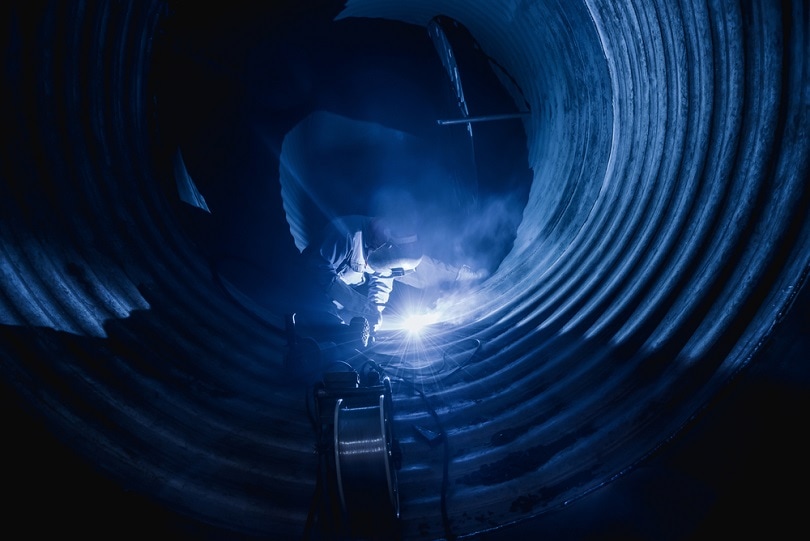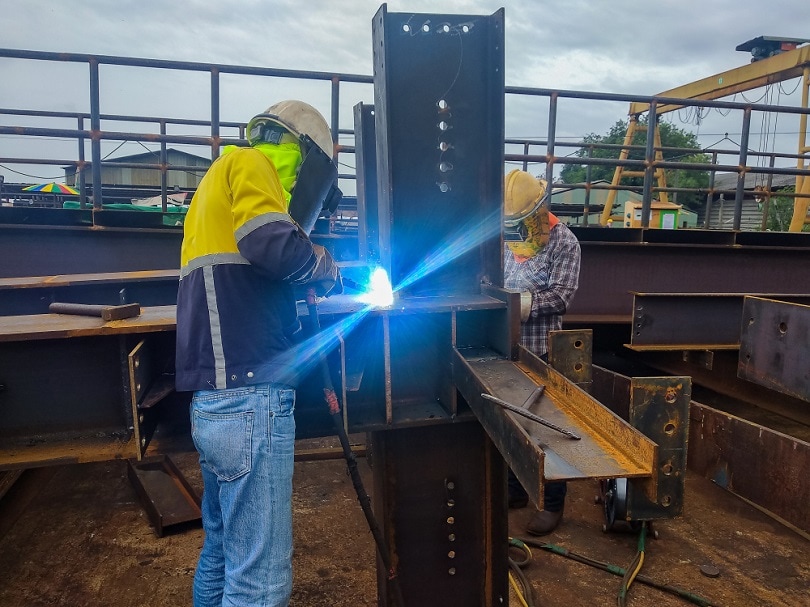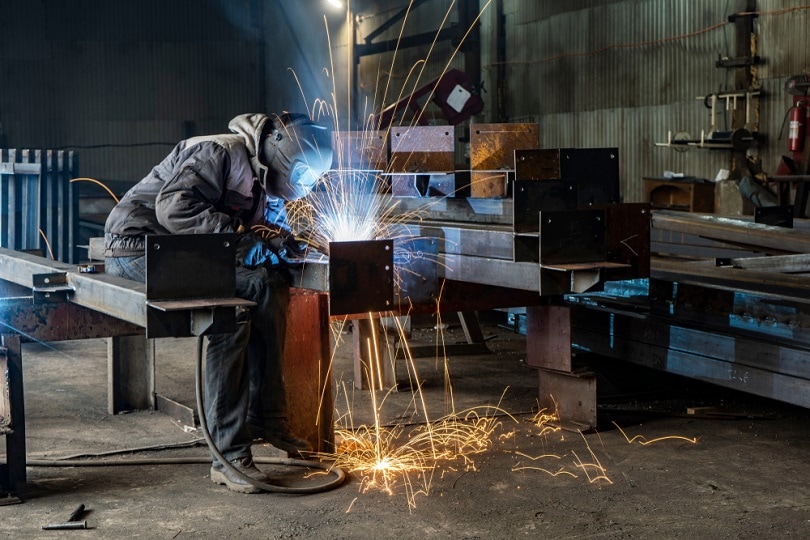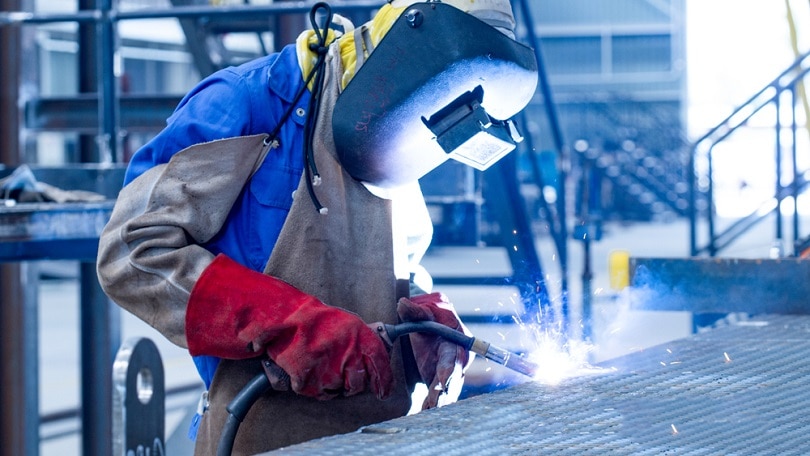What is Flux-Cored Arc Welding? Understanding it Thoroughly
Last Updated on

How Does Flux-Cored Arc Welding Work?
Flux-cored welding uses the same equipment as MIG welding. This includes welder/inverter, wire feeder, semi-automatic welding gun, and ground clamp. Since the power source is based on CV (constant voltage) which can be adjusted, this means that the arc length will stay constant throughout welding. The overall current can be changed by increasing or decreasing the wire-feed speed (WFS).

But Flux-cored welding differs from MIG welding in that it uses a different type of wire. MIG welding is most often called ‘hard-wire.’ While Flux-cored isn’t exactly ‘soft-wire,’ it is breakable by hand (most fabricators do not clip off their flux-cored wire with welding pliers). It is not solid all the way through. Instead, the tubular wire contains a flux on the inside. When the wire burns during welding, the burning flux is deposited into the weld pool as well.
The material from the flux rises to the top of the molten weld pool and creates a sort of temporary ‘casing’ to protect the weld while it cools. And since the flux rises to the top, when welded properly, it is not embedded in the weld itself. The resulting slag, as it is called, can then be chipped off with a slag hammer or a needle gun, leaving you with a structurally sound weld.
What Are the Different Types of Flux-Cored Arc Welding?
- Dual Shield
Also called FCAW-G, the ‘G’ denoting that it is to be used with shielding gas. The best polarity to be used with Dual Shield is DCEP (Direct Current Electrode Positive). This essentially means that about ⅔ of the heat from the arc will be focused on melting the electrode wire, while ⅓ of the heat will be focused on the workpiece. FCAW-G is called Dual Shield welding because it has two complementary ways that the weld is ‘shielded’ during welding.
The flux burns and creates a protective slag. At the same time, the shielding gas which is emitted from the gas diffuser on the welding gun helps protect the weld from outside contaminants such as oxygen. But an important thing to remember with Dual Shield FCAW is that though there are two methods of shielding the weld, both are required since the wire is designed to be used with shielding gas. If you run out of gas in the middle of welding, you can expect to see pinholes and slag inclusions in your weld! The two most common shielding gases that are used for Dual Shield are 100% carbon dioxide or less common, a mix of 75% carbon dioxide and 25% argon. The reason the mix is less common is that it is more expensive.
- Self-Shielded (Innershield)
Innershield is Lincoln Electric’s brand name for what we know as self-shielded FCAW (FCAW-S). It uses DCEN (Direct Current Electrode Negative) as its polarity. This means that about ⅔ of the heat from the arc is concentrated on the workpiece while ⅓ of the heat is burning the electrode. Unlike Dual Shield, the wire for Self-Shielded FCAW does not require a shielding gas. It is intended to be used without shielding gas. Between these two wires, this is the preferred method for those who work outdoors. Ironworkers and people who do a lot of mobile welding repairs tend to prefer Self-Shielded.
- Other Variables
These two wires that are listed are simply the two largest categories for Flux-Cored welding wire. The most common FCAW wires are geared toward welding mild steel. But others are high in nickel and are designed for welding special alloys. All of these wires come in a variety of sizes as well. In a fabrication setting, the selection will usually depend upon the WPS (Welding Procedure Specification). Wire diameter can affect the deposition rate and depending on the setting of the machine, can make or break the proper weld size.

- Dual Shield
Dual Shield welding is most often used in fabrication shops, especially those that deal with structural steel. Since it has such a high deposition rate and effective weld penetration, it has all but completely replaced Stick welding in a fabrication setting. FCAW for fabrication is one of the easier processes to learn. Most of the welding can be done in the horizontal or flat position. When the welds required are out of position, unless the workpiece is massive, it can be rotated to facilitate welding in the flat or horizontal position.
- Self-Shielded
Innershield is the preferred choice for welding outside. This makes it the favorite for those exposed to the weather. Since it is designed to be used without shielding gas, it can be used in high winds. Often in a construction setting like the erection of a skyscraper or other tall office building, Self-Shielded welding will be used in conjunction with Stick welding. This is because Self-Shielding welding uses more equipment. If the work is to be done up high, though the deposition rate is much lower, it is oftentimes easier to throw a small Arc welder in the scissor lift. Carrying the MIG equipment can be a hassle in certain situations since it’s a more complicated setup.
- See also: How Hot is a Welding Arc?
Advantages of Flux-Cored Arc Welding
- Efficiency
FCAW is one of the most efficient welding processes out there. It’s used by fabricators and construction workers alike. The primary reason that it is used so widely is its efficiency. The deposition rate can be 10 times higher than Stick welding. Since the filler metal runs off of a wire-feeder, this also means that you will not have to make as many stops and starts. With SMAW, 14-inch rod electrodes will not get you as many passes as FCAW.
- Facility
Depending upon the application, this is one of the easiest welding processes to learn. While no welding process is easy to learn, welding instructors often recommend that their students get their certification in FCAW-G since it is one of the easier tests to pass and it opens up more job opportunities. FCAW uses a welding gun as used in standard MIG welding. The arc is relatively stable due to the CV current. The welding gun is easier to control than a 14-inch electrode hanging out of a stinger (Stick electrode holder).
Disadvantages of Flux-Cored Arc Welding
- Environment Specific
While it is true that FCAW can be used outside with Self-Shielded, and indoors with Dual-Shield, there are cases where this rule does not apply. The carbon-dioxide or other shielding gas can be blown away even from a mild breeze blowing into the shop or work area. This can be remedied in a variety of ways.
Even though Self-Shielded can be used outdoors, even in inclement weather, it is not a safeguard against water. A little moisture near the weld zone is not going to hurt, but it’s not recommended that you weld over a puddle of water either.
- Defects
Okay, so defects are a problem in all welding processes. They are almost exclusively due to user error. But there is an additional downside to flux-cored arc welding defects. If you weld fast, you make mistakes equally fast. There’s nothing worse than laying a root pass in overhead for a groove weld only to find out that it was full of porosity because you ran out of gas. This means you will have to grind, or carbon-arc gouge the weld out and start over. Not fun to do if you’re working overhead! Common defects with FCAW are undercut (where the base metal is penetrated but not filled in) slag inclusions (pockets of flux stuck in the weld), porosity (pinholes in the weld appearance), and lack of fusion.

Frequently Asked Questions (FAQs)
Can You Weld Flux-Cored Outdoors?
We discussed that self-shielded FCAW is the preferred option for welding outdoors since it is designed for being exposed to the weather. However, there are situations where you either don’t have the proper self-shielded wire, or you are not certified to weld self-shielded FCAW. The arc characteristics of Dual Shield are much smoother and preferable as well. So, the question is, “If the wind and light breezes can blow away the gas, how can I weld Dual Shield outdoors?” There are a few things you can do.
First, is to turn up your shielding gas to a higher CFH (cubic feet per hour). This will provide you with more gas coverage to counteract the wind. Secondly, utilize welding screens, fire blankets, cardboard, or any sort of barrier that you can find to simulate welding ‘indoors,’ outdoors. Do note that turning your shielding gas up too high on the regulator attached to the gas cylinder, can cause strain and damage over time to the regulator.
Why is CO2 Preferred as a Shielding Gas for FCAW?
The reasons for this are two-fold. The first is that it is less expensive than the 75/25 Argon-CO2 mix. Flux-Cored welding when used with CO2 tends to also dig more into the metal. This can be frustrating especially when you have to clean out the divots made before welding again. Some students who are trained using 75/25 mix come to a rude awakening when they have to weld with 100% carbon dioxide for this reason. Even though this might seem like a drawback, it provides better joint penetration when welded properly.
Is a Flux-Cored Welding Machine Good for Home Use?
That all depends on the type of work that you will be doing. The welds that FCAW produces are strong but not necessarily aesthetically pleasing. If you have to repair a trailer it can be a good option. But it’s probably not the best for an art project. Standard MIG hard wire can produce cleaner-looking welds if you need it to look pretty.
Final Thoughts
There is no other welding process that is as versatile as it is productive in different climates. It has improved several different industries due to its efficiency, teachability, and availability. What started as an alternative to Stick welding nearly 75 years ago has taken the fabrication and construction industry by storm.
See Also: FCAW vs GMAW: Differences, & When to Use Them
Featured image credit: N_Sakarin, Shutterstock
